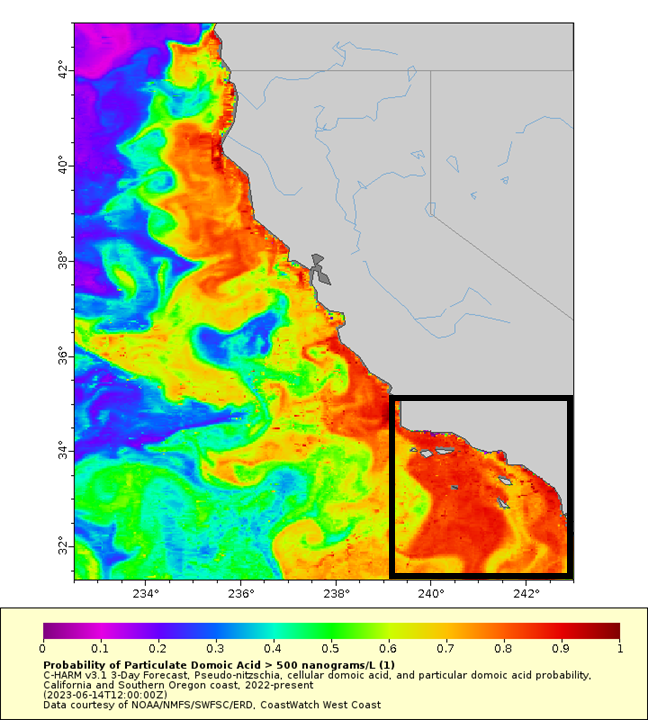NOAA’s National Centers for Coastal and Ocean Science (NCCOS) Harmful Algal Bloom (HAB) Event Response program awarded $12,550 to Southern California Coastal Water Research Project (SCCWRP), University of California- Santa Cruz, The Marine Mammal Center, Scripps Institution of Oceanography, and Southern California Coastal Ocean Observing System (SCCOOS). These funds will support research to investigate the potential links between ongoing marine mammal strandings occurring off of Southern California and a suspected offshore Pseudo-nitzschia bloom.

Blooms of the harmful algae Pseudo-nitzschia can produce domoic acid (DA), a neurotoxin. DA can accumulate in small fish and shellfish and can lead to severe illness or death in marine mammals and seabirds that feed on those animals. Previous blooms of Pseudo-nitzschia in Southern California have been associated with DA intoxication, strandings, and deaths of marine mammals.
Last month, the West Coast Marine Mammal Stranding Network, coordinated by NOAA Fisheries, received hundreds of calls daily about sick and injured dolphins and California sea lions. Stranded sea lions exhibited symptoms of DA intoxication consistent with previous Pseudo-nitzschia bloom events; symptoms of DA intoxication can include head bobbing, swaying, foaming at the mouth, bulging eyes, paralysis, involuntary muscle spasms, and seizures. One of the primary goals of the current research is to determine DA levels in marine wildlife, including marine mammals experiencing severe symptoms from potential DA exposure and prey items that may be transferring DA to those animals.
Marine wildlife toxin data from this event response project can also benefit efforts to forecast Pseudo-nitzschia blooms in the region through the California Harmful Algae Risk Mapping (C-HARM) system. Earlier this summer C-HARM predicted elevated DA for the region, when many of the marine mammal strandings were first reported.
Another major goal of the project is to collect offshore water samples to characterize DA concentrations, to complement ongoing pier-based monitoring efforts. In Southern California, the SCCOOS Harmful Algal Bloom Monitoring and Alert Program (HABMAP) performs weekly pier monitoring for Pseudo-nitzschia and other HABs. This project will expand water sampling in offshore areas, providing critical data to understand the presence and toxicity of Pseudo-nitzschia.
This project builds off of efforts initiated last fall to investigate unusual marine mammal strandings in Southern California and links to a suspected offshore Pseudo-nitzschia bloom at that time. Interestingly, marine mammal strandings this year and last have not coincided with high numbers of Pseudo-nitzschia cells in nearshore samples, suggesting possible offshore blooms.
NCCOS-supported HAB Event Response researchers are collaborating with the Santa Barbara Channelkeeper, Los Angeles Waterkeeper, and the Aquarium of the Pacific to collect offshore water samples on cruises of opportunity. This award will provide these collaborators with HAB sampling kits and training to expand HAB sampling capacity.
The NCCOS HAB Event Response Program provides immediate support to help state, tribal, and local officials manage events and advance the understanding of HABs as they occur.
For more information about the NCCOS HAB Event Response Program, contact sarah.pease@noaa.gov.
Stranded sea lions, dolphins, and other marine mammals can be reported to the West Coast Region Stranding Hotline: (866) 767-6114. For stranded live animals in Ventura and Santa Barbara Counties, residents should call Channel Islands Marine & Wildlife Institute’s Rescue Hotline at (805) 567-1505. For dead whales and dolphins in those counties, people should call Channel Island Cetacean Research Unit at (805) 500-6220.
Partner Links:
- Southern California Coastal Water Research Project (SCCWRP)
- Southern California Coastal Ocean Observing System (SCCOOS)
- Scripps Institution of Oceanography
- The Marine Mammal Center
- Biological and Satellite Oceanography Lab, UCSC
- Aquarium of the Pacific
- Los Angeles Waterkeeper
- Santa Barbara Channelkeeper
- West Coast Marine Mammal Stranding Network
- CoastWatch West Coast
